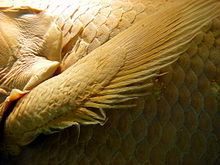Coelacanth
![]()
This article is about the order. For the living species discovered in 1938, see Comorian coelacanth.
The coelacanths (Coelacanthiformes "hollow spiny fishes", from ancient Greek κοῖλ-ος koilos "hollow" and ἄκανθ-α akantha "spine", "thorn"; also Coelacanthimorpha, Actinistia) are a group of bony fishes in the class Sarcopterygii (flesh fins). Their closest relatives are the lungfishes (Dipnoi) and the terrestrial vertebrates (Tetrapoda).
Fossil are known about 70 species of coelacanths in 28 genera. Their fossil record begins in the Lower Devonian about 409 million years ago and breaks off in the Late Upper Cretaceous more than 70 million years ago. Therefore, until the discovery of the recent Comoro coelacanth (Latimeria chalumnae) in 1938 in the Indian Ocean off South Africa, it was assumed that coelacanths had not survived the mass extinction at the end of the Cretaceous 65 million years ago. In 1997, a very similar second species, the Manado coelacanth (Latimeria menadoensis), was discovered off the Indonesian island of Sulawesi. Coelacanths are considered one of the best known examples of living fossils.
Naming
The name "coelacanth" comes from the obsolete scientific name "Crossopterygii" (Gr. krossos "something protruding", "tassel") and refers to the brush- or tassel-shaped formation of the six rudder fins (P, V, D2 and A). The taxon "Crossopterygii" is now obsolete and is considered paraphyletic, since it united the two series Actinistia (with the recent Latimeria) and the fossil Rhipidistia, which were closer to the terrestrial vertebrates.
In classification, there are minor inconsistencies in nomenclature between the taxa class and order. For example, in one system (Nelson, 2006), which is most commonly used, the Actinistia and the Coelacanthimorpha are treated synonymously and considered a subclass. In the other, less commonly used system, the Coelacanthimorpha are considered infraclass and the Actinistia subclass. There is agreement on the nomenclature in both cases for the order (Coelacanthiformes) and the class (Sarcopterygii). The term "coelacanth" is not clearly assigned to any taxon. For Coelacanthimorpha, the name "Gombessa" is occasionally used colloquially.
Physique
A common feature (synapomorphy) of coelacanths and lungfishes is the partially ossified and muscled skeleton of the pectoral and pelvic fins. They are therefore grouped into the class of flesh or muscle fins (Sarcopterygii). However, the second dorsal and anal fins are similarly constructed, allowing the fish to maneuver with precision locally. The anterior dorsal fin is characteristically spiny developed for the Actinistia (a parallel to the D1 of the Acanthopterygii - to which gr. aktis "ray" should refer).
The construction of the pectoral and pelvic fins resembles that of the limbs of terrestrial vertebrates. Presumably, early coelacanth species used their muscular fins for locomotion on the sea floor, possibly also on land. A fat-filled bladder-like organ on the intestine, interpreted as a rudiment of a swim bladder that could also be used as a lung, is thought to indicate the ability of the "Ur-Latimeria" to breathe air. In recent lungfishes, such an organ is still present and functional.
Coelacanths have a joint in the skull. This joint allows them to raise the upper jaw relative to the back of the skull to increase the mouth opening when feeding. Also important for food acquisition is the rostral organ, a cavity in the skull at the tip of the snout, with whose sensory cells Latimeria perceives electric fields such as those surrounding all living animals. Many more primitive fishes, including sharks, have similar electroreceptors.
Latimeria grows up to two meters long and weighs 100 kilograms. However, the brain of such a fish weighs only a few grams. It occupies very little space in the cranial cavity, through which also passes the aforementioned joint, and which is otherwise filled with a greasy lymphoid tissue.

Pectoral fin of a Comorian coelacanth in the Natural History Museum
Questions and Answers
Q: What is a coelacanth?
A: A coelacanth is a type of fish in the Sarcopterygii, the lobe-finned fishes.
Q: Are coelacanths related to tetrapods?
A: Yes, coelacanths are a sister group to those fish which evolved into tetrapods.
Q: How long does the fossil record of coelacanths go back?
A: The fossil record of coelacanths goes back 400 million years.
Q: Was the coelacanth thought to be extinct?
A: Yes, it was thought to be extinct for 80 million years.
Q: Where was the first coelacanth caught after it was thought extinct?
A: The first coelacanth was caught off the east African coast in 1938.
Q: Were there any places where coelacanths were still being caught before it was caught in 1938?
A: Yes, fisherman in the Comoros islands had been catching coelacanths for a very long time and called it gombesa.
Q: How many species of coelacanths are there in the Indian Ocean?
A: There are at least two species of coelacanths living in the Indian Ocean.
Search within the encyclopedia